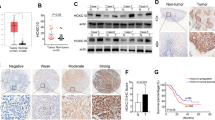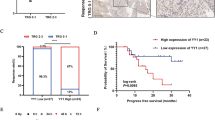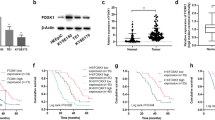Abstract
Radiotherapy is an effective treatment for some esophageal cancers, but the molecular mechanisms of radiosensitivity remain unknown. RUNX3, a novel tumor suppressor of gastric cancer, functions in transforming growth factor (TGF)-β-dependent apoptosis. We obtained paired samples from 62 patients with advanced esophageal cancers diagnosed initially as T3 or T4 with image diagnosis; one sample was obtained from a biopsy before presurgical radiotherapy, and the other was resected in surgical specimens after radiotherapy. RUNX3 was repressed in 67.7% cases of the pretreatment biopsy samples and 96.7% cases of the irradiated, resected samples. The nuclear expression of RUNX3 was associated with radiosensitivity and a better prognosis than cytoplasmic or no RUNX3 expression (P<0.003); cytoplasmic RUNX3 expression was strictly associated with radioresistance. RUNX3 was downregulated and its promoter was hypermethylated in all radioresistant esophageal cancer cell lines examined. Stable transfection of esophageal cancer cells with RUNX3 slightly inhibited cell proliferation in vitro, enhanced the antiproliferative and apoptotic effects of TGF-β and increased radiosensitivity in conjunction with Bim induction. In contrast, transfection of RUNX3-expressing cells with a RUNX3 antisense construct or a Bim-specific small interfering RNA induced radioresistance. Treatment with 5-aza-2′-deoxycytidine restored RUNX3 expression, increased radiosensitivity and induced Bim in both control and radioresistant cells. These results suggest that RUNX3 silencing promotes radioresistance in esophageal cancers. Examination of RUNX3 expression in pretreatment specimens may predict radiosensitivity, and induction of RUNX3 expression may increase tumor radiosensitivity.
This is a preview of subscription content, access via your institution
Access options
Subscribe to this journal
Receive 50 print issues and online access
$259.00 per year
only $5.18 per issue
Buy this article
- Purchase on Springer Link
- Instant access to full article PDF
Prices may be subject to local taxes which are calculated during checkout






Similar content being viewed by others
Abbreviations
- 5-Aza-dCyt:
-
5-aza-2′-deoxycytidine
- CR:
-
complete response
- MSP:
-
methylation-specific PCR
- PR:
-
partial response
- NC:
-
no change
- siRNA:
-
small interfering RNA
- TGF:
-
transforming growth factor
References
Alcock RA, Dey S, Chendil D, Inayat MS, Mohiuddin M, Hartman G et al. (2002). Farnesyltransferase inhibitor (L-744, 832) restores TGF-beta type II receptor expression and enhances radiation sensitivity in K-ras mutant pancreatic cancer cell line MIA PaCa-2. Oncogene. 2002: 21:7883–21:7890.
Biard DS, Martin M, Rhun YL, Duthu A, Leaix JL, May P . (1994). Concomitant p53 gene mutation and increased radiosensitivity in rat lung embryo epithelial cells during neoplastic development. Cancer Res 54: 3361–3364.
Chi XZ, Yang JO, Lee KY, Ito K, Sakakura C, Li QL et al. (2005). RUNX3 suppresses gastric epithelial cell growth by inducing p21(WAF1/Cip1) expression in cooperation with transforming growth f. Mol Cell Biol 25: 8097–8107.
Coleman CN, Stevenson MA . (1996). Biologic basis for radiation oncology. Oncology 10: 399–411.
Dewey WC, Ling CC, Meyn RE . (1995). Radiation-induced apoptosis: relevance to radiotherapy. Int J Radiat Oncol Biol Phys 33: 781–796.
Eifel PJ, Morris M, Wharton JT, Oswald MJ . (1994). The influence of tumor size and morphology on the outcome of patients with FIGO stage IB squamous cell carcinoma of the uterine cervix. Int J Radiant Oncol Biol Phys 29: 9–16.
Ewan KB, Henshall-Powell RL, Ravani SA, Pajares MJ, Arteaga C, Warters R et al. (2002). Transforming growth factor-beta1 mediates cellular response to DNA damage in situ. Cancer Res 62: 5627–5631.
Fukuchi M, Masuda N, Miyazaki T, Nakajima M, Osawa H, Kato H et al. (2002). Decreased Smad4 expression in the transforming growth factor-beta signaling pathway during progression of esophageal squamous cell carcinoma. Cancer 95: 737–743.
Fukuda K, Sakakura C, Miyagawa K, Kuriu Y, Kin S, Nakase Y et al. (2004). Differential gene expression profiles of radioresistant oesophageal cancer cell lines established by continuous fractionated irradiation. Br J Cancer 91: 1543–1550.
Japanese Society for Esophageal Disease. (1999). General Rules for Clinical and Pathological Studies on Cancer of the Esophagus, 5th edn.
Hanahan D, Weinberg RA . (2000). The hallmarks of cancer. Cell 100: 57–70.
Hanai J, Chen LF, Kanno T, Ohtani-Fujita N, Kim WY, Guo WH et al. (1999). Interaction and functional cooperation of PEBP2/CBF with Smads. Synergistic induction of the immunoglobulin germline C alpha promoter. J Biol Chem 274: 31577–31582.
Hanna E, Shrieve DC, Ratanatharathorn V, Xia X, Breau R, Suen J et al. (2001). A novel alternative approach for prediction of response of squamous cell carcinoma of head and neck. Cancer Res 61: 2376–2380.
Herman JG, Graff JR, Myohanen S, Nelkin BD, Baylin SB . (1993). Methylation-specific PCR: a novel PCR assay for methylation status of CpG islands. Proc Natl Acad Sci USA 93: 9821–9826.
Hsiao M, Tse V, Carmel J, Costanzi E, Strauss B, Haas M et al. (1997). Functional expression of human p21 (WAFI/CIPI) gene in rat glioma cells suppresses tumor growth in vivo and induces radiosensitivity. Biochem Biophys Res Commun 233: 329–335.
Ito K, Liu Q, Salto-Tellez M, Yanao T, Tada K, Ida H et al. (2005). RUNX3, a novel tumor suppressor, is frequently inactivated in gastric cancer by protein mislocalization. Cancer Res 65: 7743–7750.
Kasid U, Pfeifer A, Weichselbaum RR, Dritschilo A, Mark GE . (1987). The raf oncogene is associated with a radiation-resistant human laryngeal cancer. Science 237: 1039–1041.
Kim AH, Lebman DA, Dietz CM, Snyder SR, Eley KW, Chung TD et al. (2003). Transforming growth factor-beta is an endogenous radioresistance factor in the esophageal adenocarcinoma cell line OE-33. Int J Oncol 23: 1593–1599.
Kim WJ, Kim EJ, Jeong P, Quan C, Kim J, Li QL et al. (2005). RUNX3 inactivation by point mutations and aberrant DNA methylation in bladder tumors. Cancer Res 65: 9347–9354.
Kitada S, Krajewski S, Miyashita T, Krajewska M, Reed JC . (1996). Gamma-radiation induces upregulation of Bax protein and apoptosis in radiosensitive cells in vivo. Oncogene 12: 187–192.
Kitahara O, Katagiri T, Tsunoda T, Harima Y, Nakamura Y . (2002). Classification of sensitivity or resistance of cervical cancers to ionizing radiation according to expression profiles of 62 genes selected by cDNA microarray analysis. Neoplasia 4: 295–303.
Li QL, Ito K, Sakakura C, Fukamachi H, Inoue K, Chi XZ et al. (2002). Causal relationship between the loss of RUNX3 expression and gastric cancer. Cell 109: 113–124.
Maity A, Kao GD, Muschel RJ, McKenna WG . (1997). Potential molecular targets for manipulating the radiation response. Int Radiat Oncol Biol Phys 3: 639–653.
Massague J, Blain SW, Lo RS . (2000). TGFbeta signaling in growth control, cancer, and heritable disorders. Cell 103: 295–309.
Matsumura Y, Yamagishi N, Miyakoshi J, Imamura S, Takebe H . (1997). Increase in radiation sensitivity of human malignant melanoma cells by expression of wild-type p16 gene. Cancer Lett 115: 91–96.
Meyn RE, Stephens LC, Milas L . (1996). Programmed cell death and radioresistance. Cancer Metast Rev 15: 119–131.
Nakase Y, Sakakura C, Miyagawa K, Kin S, Fukuda K, Yanagisawa A et al. (2005). Frequent loss of RUNX3 gene expression in remnant stomach cancer and adjacent mucosa with special reference to topography. Br J Cancer 92: 562–569.
Natsugoe S, Xiangming C, Matsumoto M, Okumura H, Nakashima S, Sakita H et al. (2002). Smad4 and transforming growth factor beta1 expression in patients with squamous cell carcinoma of the esophagus. Clin Cancer Res 8: 1838–1842.
Nishihira T, Hashimoto Y, Katayama M, Mori S, Kuroki T . (1993). Molecular and cellular features of esophageal cancer cell lines. J Cancer Res Clin Oncol 119: 441–449.
Sakakura C, Hagiwara A, Nakanishi M, Shimomura K, Takagi T, Yasuoka R et al. (2002). Differential gene expression profiles of gastric cancer cells established from primary tumour and malignant ascites. Br J Cancer 87: 1153–1161.
Sakakura C, Hasegawa K, Miyagawa K, Nakashima S, Yoshikawa T, Kin S et al. (2005). Possible involvement of RUNX3 silencing in the peritoneal metastases of gastric cancers. Clin Cancer Res 11: 6479–6488.
Sakakura C, Sweeney EA, Shirahama T, Igarashi Y, Hakomori S, Nakatani H et al. (1996). Overexpression of bax sensitizes human breast cancer MCF-7 cells to radiation-induced apoptosis. Int J Cancer 67: 101–105.
Sakakura C, Yamaguchi-Iwai Y, Satake M, Bae SC, Takahashi A et al. (1994). Growth inhibition and induction of differentiation of t(8;21) acute myeloid leukemia cells by the DNA-binding domain of PEBP2 and the AML1/MTG8(ETO)-specific antisense oligonucleotide. Proc Natl Acad Sci USA 91: 11723–11727.
Shimada Y, Imamura M, Wagata T, Yamaguchi N, Tobe T . (1992). Characterization of 21 newly established esophageal cancer cell lines. Cancer 69: 277–284.
Sinclair WK, Morton RA . (1966). X-ray sensitivity during the cell generation cycle of cultured Chinese hamster cells. Radiat Res 29: 450–474.
Sklar MD . (1988). The ras oncogenes increase the intrinsic resistance of NIH 3T3 cells to ionizing radiation. Science 239: 645–647.
Sobin LH, Fleming ID . (1997). TNM Classification of malignant tumors. 5th ed. Union Internationale Contre le Cancer and the American Joint Committee on Cancer. Cancer 80: 1803–1804.
Vodovotz Y, Lucia MS, DeLucca AM, Mitchell JB, Kopp JB . (2000). Hematopoietic function and enhanced radiosensitivity of transforming growth factor-beta1 transgenic mice. Int J Cancer 90: 13–21.
Willis SN, Adams JM . (2005). Life in the balance: how BH3-only proteins induce apoptosis. Curr Opin Cell Biol 17: 617–625.
Yamamura Y, Lee WL, Inoue KI, Ida H, Ito Y . (2006). RUNX3 cooperates with FoxO3a to induce apoptosis in gastric cancer cells. J Biol Chem 281: 5267–5276.
Yano T, Ito K, Fukamachi H, Chi XZ, Wee HJ, Inoue K et al. (2006). The RUNX3 tumor suppressor upregulates Bim in gastric epithelial cells undergoing TGF-β-induced apoptosis. Mol Cell Biol. 26: 4474–4488.
Author information
Authors and Affiliations
Corresponding author
Rights and permissions
About this article
Cite this article
Sakakura, C., Miyagawa, K., Fukuda, KI. et al. Frequent silencing of RUNX3 in esophageal squamous cell carcinomas is associated with radioresistance and poor prognosis. Oncogene 26, 5927–5938 (2007). https://doi.org/10.1038/sj.onc.1210403
Received:
Revised:
Accepted:
Published:
Issue Date:
DOI: https://doi.org/10.1038/sj.onc.1210403
Keywords
This article is cited by
-
RUNX3 regulates the susceptibility against EGFR-targeted non-small cell lung cancer therapy using 47Sc-conjugated cetuximab
BMC Cancer (2023)
-
Radiotherapy resistance: identifying universal biomarkers for various human cancers
Journal of Cancer Research and Clinical Oncology (2022)
-
Elevated expression of RUNX3 co-expressing with EZH2 in esophageal cancer patients from India
Cancer Cell International (2020)
-
Exosome-derived miR-339-5p mediates radiosensitivity by targeting Cdc25A in locally advanced esophageal squamous cell carcinoma
Oncogene (2019)
-
Inactivation of RUNX3 predicts poor prognosis in esophageal squamous cell carcinoma after Ivor-Lewis esophagectomy
Medical Oncology (2014)



